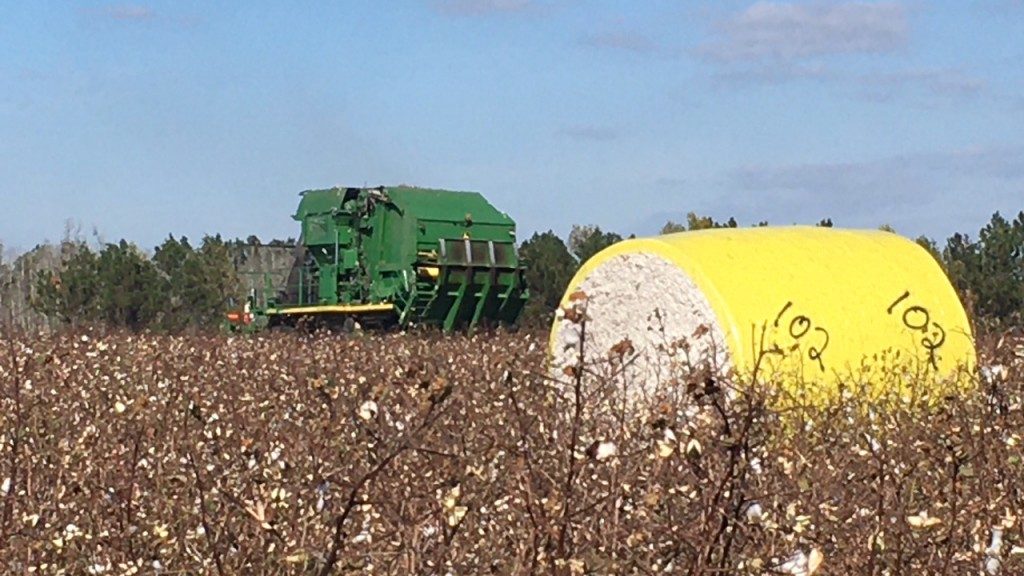Current Situation: The peanut crop ranges from 60 to 90 days old. There have been a few calls about low levels of spider mites in the community in dryland fields. Caterpillar pressure has been on the low side this year. PGR applications are still going out, and hopefully it will rain in our near future. White mold applications have been applied. The cotton crop ranges from squaring to 7 week of bloom. Spider mite and whitefly populations have increased this week. A couple of fields have been treated for whitefly. Corn is drying down, and harvest has begun.
The drought monitor this week shows that abnormally dry conditions have expanded over all of Colquitt County. Rain is forecasted over the next few days which could help with the irrigation effort in cotton and peanuts.
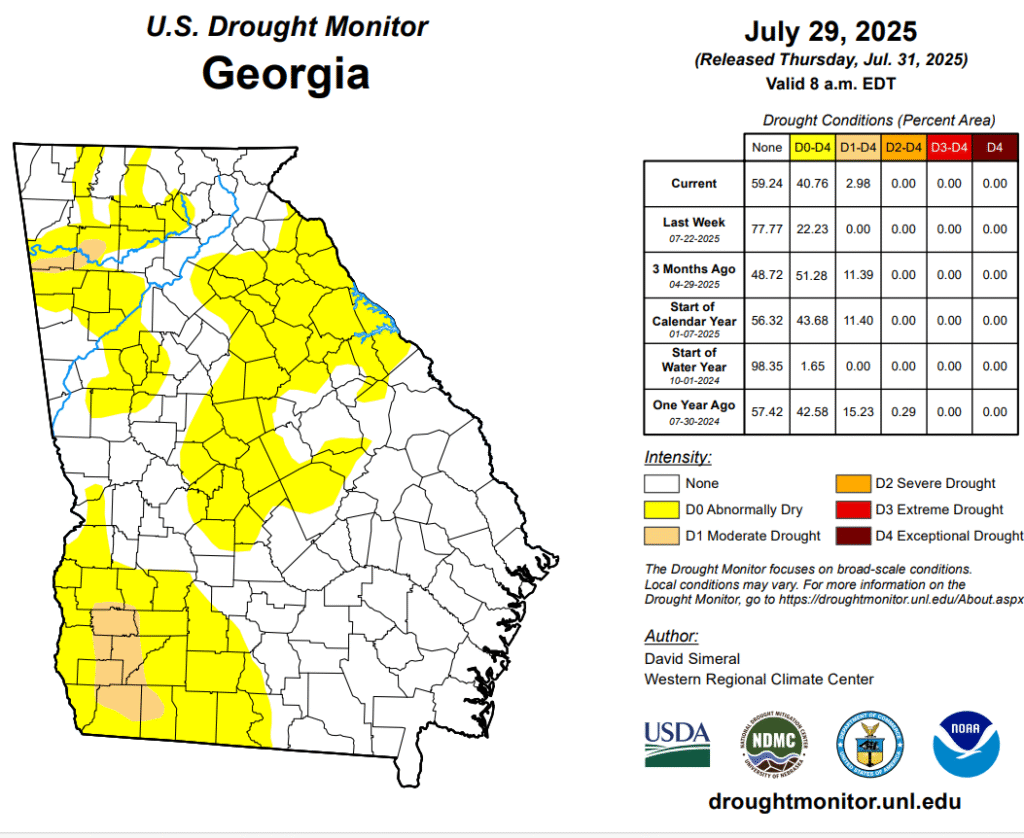
It has been hot this past July. Pam Knox, UGA Climatologist, says the preliminary data for July 2025 shows that most of the region was warmer than normal and quite a bit of it was also drier than normal. The exception for precipitation was in North Carolina and Virginia where TS Chantal brought torrential rain to central parts of NC and then NE into Virginia early in the month. In Virginia, nearly the entire state had above-normal rainfall during July. Alabama was the only state with a significant portion of the state experiencing cooler than normal temperatures. READ MORE
The illustration below shows the daily normal and extreme temperatures from a weather station in Moultrie (Source: Midwestern Regional Climate Center). The green is the normal temperature ranges. The red line represents record temperatures and the toward the end of the month the high temperatures were near the red line.

According to Pam Knox, August 2025 expected to be wetter than normal, especially in Georgia and South Carolina and surrounding areas. The latest monthly outlook for August 2025 shows that the region is slightly like to be warmer than normal this month. The signal for above-normal rainfall is much stronger, with heavier than usual rain most likely in nearly all of Georgia plus SE Alabama and the Florida Panhandle. This is probably in large part due to the heavy rain expected in the next week plus the anticipated ramp-up of the tropics later in the month. READ MORE.
Corn: This has been an interesting week. This week (7-28), tar spot was found in a Colquitt County cornfield that was past black layer. The tar spot in this field was very low in severity. Dr. Bob says that tar spot has been found in Ben Hill, Tift, Grady, and Colquitt Counties. The illustration below is from the Crop Protection Network, and it shows the most current tar spot detections.

Here is an overview of Tar spot if you are interested.

Corn harvest is on around the corner. Below is information from the UGA publication Reducing Aflatoxin in Corn during Harvest and Storage. Here’s an excerpt:
Research shows most Aspergillus infections occur in broken and damaged kernels and in foreign material. Damage to the grain seed coat allows the easy entrance of molds and fungi and promotes the rapid development of storage rots at high moisture and temperature levels. Heat and drought stress can cause seed coat fractures and increase the opportunity for infection to occur. Aflatoxin can develop within 24 hours in mold- and fungus-infected corn stored under these conditions, even though the corn was previously free of aflatoxin.
Harvesting must be done in such a way to prevent damage to the seed coat and to ensure maximum cleaning of the grain, since damaged seed and foreign material contribute to the development of aflatoxin. The following practices will reduce the likelihood of this problem.
When corn reaches maturity, harvest at once and dry mechanically. Harvest should begin when the moisture level reaches 28 to 30 percent. Studies have shown that most corn hybrids will normally lose about 0.5 to 0.6 percent of their moisture per day during the dry-down period. You can reduce field exposure by at least 1 to 2 1/2 weeks by harvesting above 22 percent moisture compared to letting corn dry in the field at 15 percent or less. This will require immediate drying, however. READ MORE
The key to storing grains and other commodities on the farm is to make storage conditions unfavorable for the survival of stored grain insects and fungi. The following steps are designed to reduce the initial number of insects in the bin, slow the development of any remaining insects, and apply corrective measures to reduce insect populations if necessary. Following these steps will also greatly
reduce stored grain molds and associated mycotoxins.
- Clean storage facilities thoroughly inside and out to eliminate starter colonies of insects. Remove any weeds, crop debris, or clutter around the facility to reduce insect and rodent activity. All grain residues from the previous year should be removed from inside the facility as soon as the old crop is shipped.
- Seal any gaps or holes in the sides and roof of the bin using caulk or polyurethane foam. Check to make sure the bottom seal with the concrete is intact. Prevent water from flowing underneath the bin by applying plastic roof cement.
Cotton: There have been a few questions about the cotton jassid or the two spotted cotton leaf hopper. Dr. Roberts spoke about this pest this past winter. Adults are recognized by a black dot on each wing. Below is a pest alert from Florida that Dr. Roberts distributed last week on the Two spotted cotton leaf hopper. PEST ALERT: Two-spot cotton leafhopper
We also found this pest in a cotton field or two locally. Below are some observations of what we found. The picture on the upper left shows the two dots and the picture on the right shows damage from the two spotted cotton leaf hopper. Dr. Sparks did a blog post about this pest and information on bioassays conducted in vegetables. Dr. Roberts will be providing more management information on this insect this week.

Average silverleaf whitefly (SLWF) captures per week from all traps (see whitefly monitoring map for trap locations). Means are presented as SLWF adult captures per week beginning in April 2020 and continuing at weekly intervals.
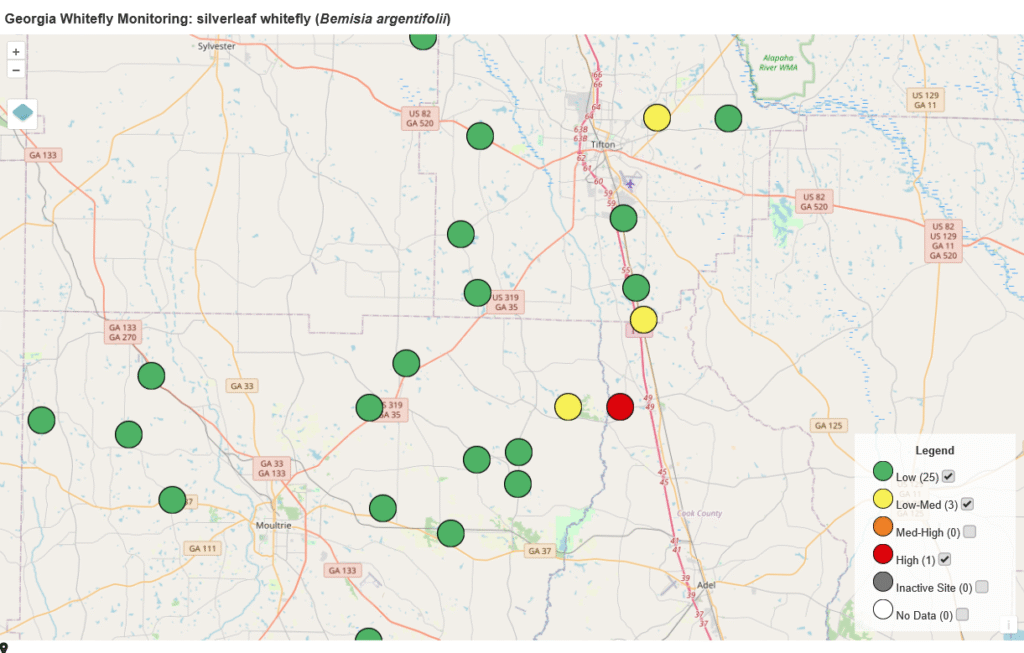
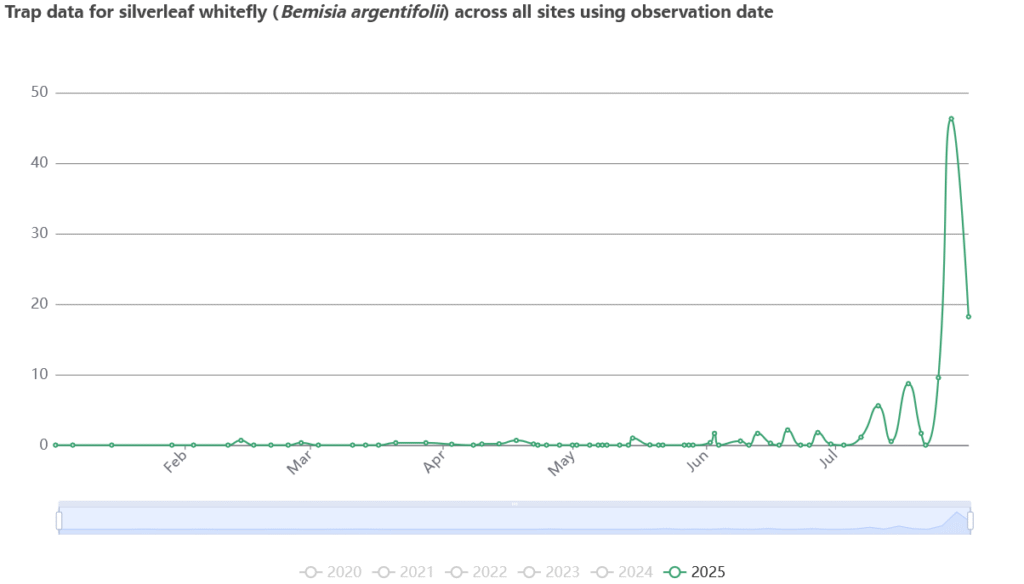
Below is a link to Season 2, Episode 17 of the Talkin’ Cotton Podcast, which is a discussion on the current insect situation in our crop. Reminder that this link takes you straight to buzzsprout, but we also post it on Apple Podcasts, Spotify, Amazon, and other popular podcast platforms.
https://www.buzzsprout.com/2350262/episodes/17599594
Peanuts: The peanut crop ranges from 60 to 90 days old. There have been a few calls about low levels spider mites in a few dryland fields. Caterpillar pressure has been on the low side this year, but scouts, consultants, and growers are out scouting fields. PGR applications are still going out and hopefully it will rain in our near future. White mold applications have been being applied.
Below is an insect update from Dr. Mark Abney.
What’s Eating the Peanuts…End of July Update
Late July and early August are generally prime time for foliage feeding caterpillars in Georgia peanut fields. Caterpillar pressure has been relatively light so far in 2025, but I have gotten a couple reports of fields at or near threshold over the last few days. A mix of species can and will be found in peanuts this time of year. Velvetbean caterpillar, soybean looper, beet armyworm, and rednecked peanut worm are some of the most common pests you will find in mid to late summer. Proper identification is important to selecting the most efficacious and cost effective insecticide(s) when thresholds are reached.
Scouting and using thresholds to make management decisions will prevent mistakes that cost growers money. Applying insecticides to fields that are not at threshold reduces profit. Likewise, failing to manage an infestation that reaches threshold will result in economic loss.
Lesser cornstalk borer continues to be found in some fields included our UGA Peanut Entomology trials. Continue scouting, and treat this pest if thresholds are reached. Missing an LCB infestation can result in significant losses in yield and increases the risk of aflatoxin.
Folks continue to see potato leaf hoppers in peanut. Though this insect causes characteristic “hopper burn”, its economic impact is generally minimal. Three cornered alfalfa hoppers (TCAH) are related to potato leaf hoppers, but they feed on stems and petioles rather than leaves. Very high numbers of TCAH commonly occur in late August and early September, but insecticide applications are rarely warranted. Available insecticides have limited residual activity, marginal efficacy, and some increase the risk of spider mite infestation later in the season.
Hot, dry conditions favor the development of spider mite infestations. Additionally, the application of broad spectrum insecticides like pyrethroids and acephate can flare mites. If you observe wilting and/or yellowing of plants near field borders, it is worth stopping to check for mites. Finding and treating mite infestations early is critical for successful management. Increasing spray volume when miticides are applied will improve efficacy; I would not spray mites with less than 15 gallons per acre, and I prefer 20 gallons per acre. Even with increased spray volume, two applications are often needed to get mite populations under control.
If you have questions about these topics or any other pest management issue in peanut, please contact your local UGA County Extension Agent. Also, be sure to listen to the All About the Pod podcast for weekly updates from the UGA Peanut Team.
I had a question about zinc in peanuts this week. Zinc deficiency is rare in peanut, however zinc toxicity often occurs, especially when soil test zinc levels are high and soil pH is low. Zinc toxicity is often seen on new ground (low pH), old pecan orchards and old barn sites that had galvanized roofs. In order to avoid zinc toxicity, maintain soil pH at or above the levels below:

What else did we do this week? I had an opportunity to implement another cotton fungicide trial evaluating a few fungicides for the management of areolate mildew.
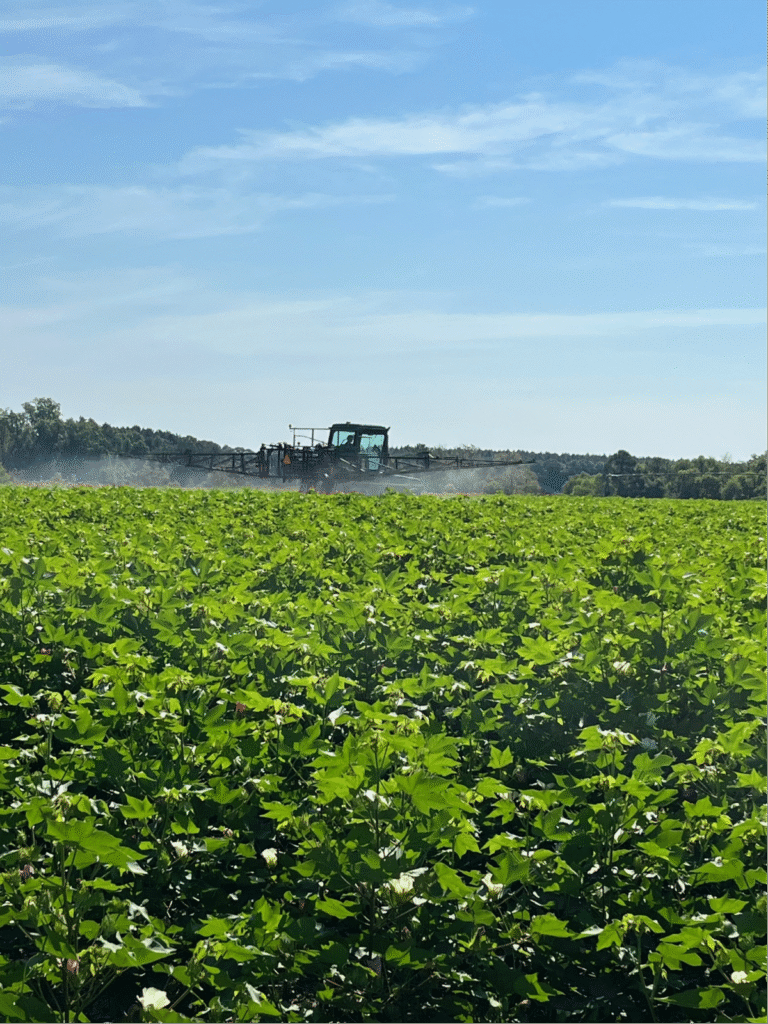
Owen Russell completed his internship with the Colquitt County Extension this week. This is a sharp young man, and hopefully he learned a lot. We had to go to his internship graduation at Rock Eagle this week. One of the requirements of the internship was completing a research project and showcasing that project on a poster. Below is the poster he presented at Rock Eagle. This summer 4 Colquitt County growers are helping us evaluate the CropFit Irrigation app in 3 cotton and 1 peanut field with an infield moisture sensor. The project aims to assess the app’s effectiveness in optimizing irrigation practices, which could ultimately lead to better crop yields and water conservation.
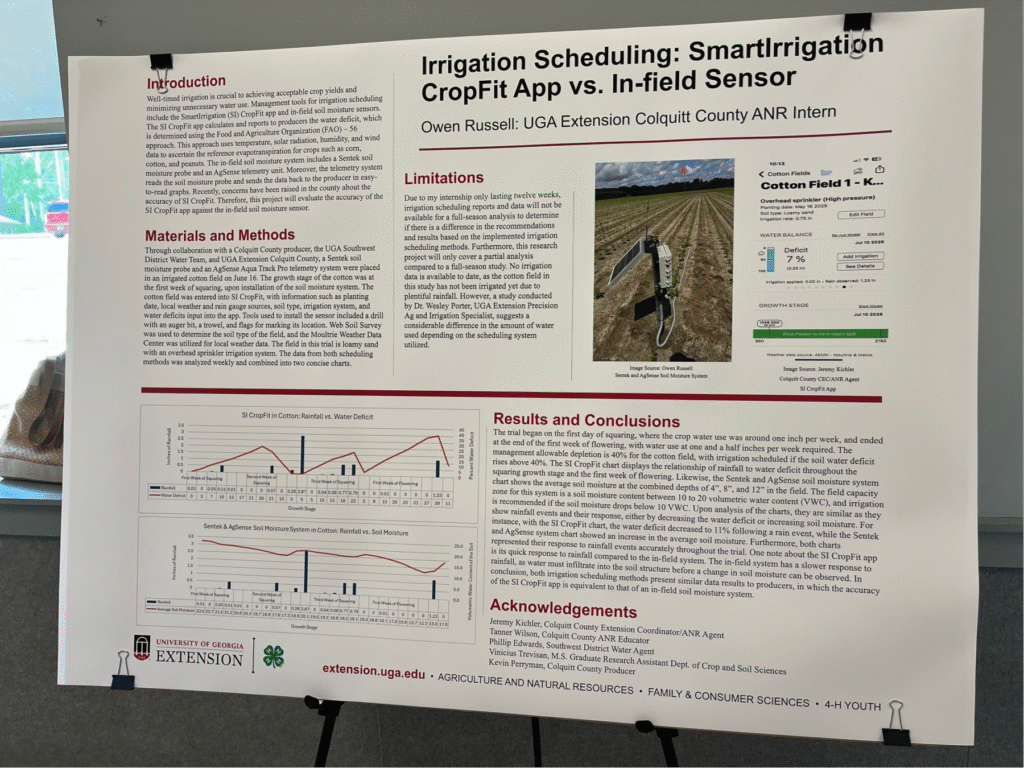
Michael Martin, Extension Director of County Operations, is presenting Owen his Internship Graduation certificate.
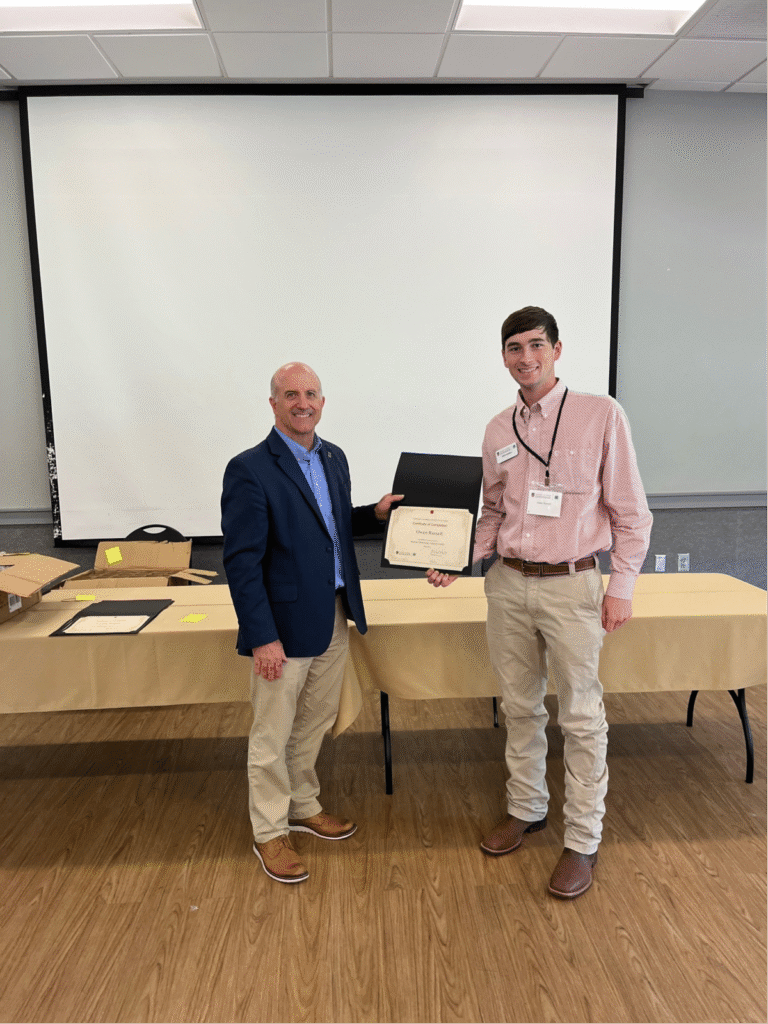
Have a safe week and if you have questions please call the office,
Jeremy M. Kichler
Colquitt County Extension Coordinator
The University of Georgia Cooperative Extension does not endorse or guarantee the performance of any products mentioned in this update.
